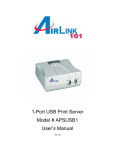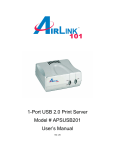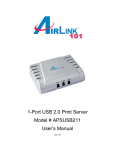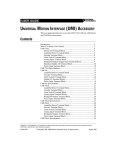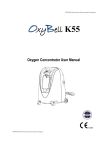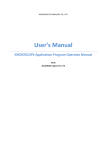Download AOpen 101 User`s manual
Transcript
3-Port Print Server Model # APSUSB203 User’s Manual Ver. 1A Table of Contents 1 Introduction.................................................................................................................................. 2 1.1 Package Contents .................................................................................................................. 2 1.2 System Requirements............................................................................................................ 2 2 Hardware Installation................................................................................................................... 3 2.1 Connecting the Print Server .................................................................................................. 3 3. Installing PS Utility..................................................................................................................... 4 4. Configuring Network Setting...................................................................................................... 6 5. Verifying Network Connection................................................................................................... 8 6. Running PS Wizard................................................................................................................... 10 7. Performing Operating System Print Test.................................................................................. 13 8. Using the PS Utility .................................................................................................................. 15 9. Setup Wizard............................................................................................................................. 16 10. Using the Web Configuration Utility...................................................................................... 19 10.1 Management...................................................................................................................... 20 10.2 Configuration .................................................................................................................... 23 10.3 Tools ................................................................................................................................. 29 10.4 Help................................................................................................................................... 33 11. Printing in Mac OS ................................................................................................................. 34 11.1 Using Rendezvous ............................................................................................................ 34 12. Appendix................................................................................................................................. 37 Technical Support ..................................................................................................................... 37 1 1 Introduction Congratulations on purchasing your 3-Port Print Server. It is the easiest and fastest way to deploy printers on your network. This compact Print Server uses your network router to connect various computers and printers together. It manages the flow of print files from computers to the connected printers, delivering print jobs to high-performance printers much faster than a file server or a PC acting as a print server can. The Print Server features a Web-based Configuration Utility, which allows you to set up the Print Server through the web browser easily and quickly. It also includes a powerful software called, PS Utility, a user-friendly program that allows you to configure some basic functions of the Print Server such as performing a factory reset or updating the firmware. 1.1 Package Contents Unpack the package and check all the items carefully, and be certain that you have: • • • • 3-Port Print Server AC Power Adapter Quick Installation Guide Installation CD containing the PS Utility program and the User’s Manual If any item contained is damaged or missing, please contact your local dealer immediately. Also, keep the box and packaging materials in case you need to ship the unit in the future. 1.2 System Requirements Operating System: • Microsoft Windows 95/98/ME/NT/2000/XP/2003 • Apple Mac OS X or above For Web Configuration: • Java-enabled web browser, such as Microsoft® Internet Explorer 5.0 or Netscape Navigator 6.0 2 2 Hardware Installation 2.1 Connecting the Print Server Warning: Only a USB printer may be connected to the USB port of the Print Server. Connecting any other USB device to the Print Server may damage the Print Server. Note: Do not plug the power cord to the Print Server until you have reached Step 4 of this section. Step 1Connect one end of the network cable to the LAN port of the Print Server and attach the other end of the cable to a router. Step 2 Make sure all the printers are powered OFF, then connect one end of the printer cable to the printer port of the Print Server and attach the other end of the cable to the printer port of the printer. Step 3 Power ON the printer(s). Step 4 Plug one end of the power cord into the Print Server and the other end into an electrical outlet. 3 3. Installing PS Utility Step 1 Insert the provided CD and wait for the autorun screen to appear. Step 2 Click on Install PS Utility. Note: If the autorun screen does not appear automatically, go to Start, Run, type D:\autorun.exe (where D is the letter of your CD drive) and click OK. Step 3 Click Next. 4 Step 4 Click Next. Step 5 Click Yes. Step 6 Click Finish. 5 4. Configuring Network Setting Before configuring the Print Server’s network setting, please take note of your computer’s TCP/IP setting. Step 1 Click on Start, Run, and type command (for Windows 95/98/ME) or cmd (for Windows 2000/XP) and click OK. Step 2 At the command prompt, type ipconfig and press Enter. Step 3 Write down the information for the IP Address, Subnet Mask, and Default Gateway. You will need these information later. Step 4 Run the PS Utility by going to Start, (All) Programs, PS-Utility, PS-Utility v3.00. Step 5 Make sure the Print Server is listed under the Device Name and click on Change IP Address. 6 Step 6 In the IP Address field, enter a valid IP address, subnet mask, and default gateway that matches your local area network. For example: If your computer’s IP Address is 192.168.1.100, enter the same three numbers: 192.168.1 in the corresponding fields. Note: You can leave the last IP Address number 254 as is unless another network device (i.e. the Default Gateway) is already using that number. If another network device is already using 254, then change it to another number that is currently not in use (preferably 200 - 253). Step 7 For the Subnet Mask and Default Gateway fields, enter the same number as the TCP/IP setting of your computer. Step 8 Click OK. Step 9 Close the PS Utility program. 7 5. Verifying Network Connection Step 1 Run the PS Utility by going to Start, (All) Programs, PS-Utility, PS-Utility v3.00. Step 2 Make sure the Print Server is detected under the Device Name. Step 3 Click on Show Web Setup to display the Print Server’s Web Configuration Utility. Step 4 Verify that the Printer Status for the connected ports display On line. 8 Step 5 Click on the Tools link, select the port you want to test and click the Test button. The Print Server will perform a low-level print test, bypassing the operating system layer. Note: Your printer should print out a test page. If not, verify that the printer is powered on and all cables are securely connected and try again. If the printer still fails to print a test page, please check the printer compatibility list on our web site at www.airlink101.com for a list of compatible printers. If your printer is not on the list, it may not be compatible with the Print Server. Step 6 Once the printer successfully prints out a test page, you may close the web browser and proceed to the next section. 9 6. Running PS Wizard Warning: Make sure you have installed the printer driver locally on every computer that will use the print server in your network before running the PS Wizard. Otherwise, the PS Wizard will not run properly. Be sure to run the PS Wizard on all the computers that will use the print server in your network. Step 1 Insert the provided CD and wait for the autorun screen to appear. Step 2 Click on Run PS Wizard. Note: If the autorun screen does not appear automatically, go to Start, Run, type D:\autorun.exe (where D is the letter of your CD drive) and click OK. 10 Step 3 Click Next. Step 4 Select the printer that is connected to the Print Server and click Next. 11 Step 5 Double-click on the Print Server, select the Printer Port that the printer is connected to and click Next. Step 6 Click Finish and OK. (For Windows 95/98/ME, you’ll need to reboot the computer). Step 7 Re-run the PS Wizard and setup any remaining printer(s) that are connected to the print server. Step 8 Run the PS Wizard on all the computers in your network that will use the print server. 12 7. Performing Operating System Print Test The final step in setting up the Print Server is to perform an operating system print test. Please note that the instructions below are for Windows XP, but the steps are similar for all the other Windows operating systems. Step 1 Click on Start, Settings, Printers and Faxes. Step 2 Right-click on the printer that is connected to the Print Server and select Properties. 13 Step 3 Click on the Print Test Page button. Windows should print out a test page. You have successfully configured the Print Server for printing. 14 8. Using the PS Utility PS Utility is a user-friendly program that allows you to configure some basic functions of the Print Server such as performing a factory reset or updating the firmware. To access the complete management features of the Print Server, you’ll need to use the Web Configuration Utility, which is described in the next section. Note: If you haven’t installed PS Utility yet, please follow the installation instructions as described in Section 3, Installing PS Utility. You can start PS Utility by going to Start, (All) Programs, PS-Utility, PS-Utility v3.00. Device Name: Lists any Print Server that is connected on your network. Discover Device: Click on this button to automatically search for any Print Server that is connected to your network. Setup Wizard: Click on this button to run the setup wizard for the Print Server. Change IP Address: Click on this button to change the IP Address and other TCP/IP settings for the Print Server. Show Web Setup: Click on this button to display the Web Configuration Utility. Update Firmware: Click on this button to update the Print Server’s firmware. Note: You must download the updated firmware from www.airlink101.com first. Factory Reset: Click on this button to reset the Print Server back to factory settings. Print Test: Click on this button to perform a print test. About: Click on this button to display the version number of the PS Utility. Close: Click on this button to close PS Utility. 15 9. Setup Wizard The Setup Wizard page allows you to configure some basic settings of the Print Server, including specifying an optional password to log in to the Web Configuration Utility. To access the Setup Wizard, click on the Setup Wizard button in PS Utility. Click Next to proceed. Server Name: You can change the Print Server’s name to a more user-friendly name. Port Name: You can change the Print Server’s port name. Password: Enter a password (optional) for logging in to the Web Configuration Utility. Click Next to proceed. 16 IP Address: Select to Manually Assign an IP Address for the Print Server (recommended) or have the router Automatically Assign an IP Address. Click Next to proceed. Workgroup: Enter the name of your Microsoft Network. Click Next to proceed. 17 AppleTalk Zone: Enter the name of your AppleTalk Zone. Printer Type: Enter the printer type for the corresponding ports. Click Next to proceed. Click Save to save the settings. 18 10. Using the Web Configuration Utility The Web Configuration Utility allows you to manage the full features of the Print Server with an easy-to-use user interface. You can start the Web Configuration Utility in two ways: 1. Click on the Show Web Setup button in PS Utility. or 2. Open your web browser (Internet Explorer or Netscape), type in the IP address of the Print Server in the Address field, and press Enter. (Default IP address is 192.168.1.254). The Web Configuration Utility will display the Management, System page. Click on any of the links at the left to display the corresponding page. 19 10.1 Management System The System page displays the status of your Print Server, printer, and network. Click Refresh to update the page. 20 Network The Network page displays the status of your local area network. Click Refresh to update the page. 21 User The User page displays the Users Printing-Log, which shows which users have submitted print jobs through the Print Server. Click Refresh to update the page. 22 10.2 Configuration Click on Configuration to display the Configuration page. System The System page allows you to configure basic settings of the Print Server. Server Name: You can rename the Print Server to a more user-friendly name or keep the factory default name. Location: You can make note of where the Print Server is located (optional). Admin Contact: Name of the administrator to contact for help (optional). Password: You can set a password for the Web Configuration Utility so only authorized personnel can access and change the Print Server’s configuration. USB1, USB2, LPT3: You can rename the Print Server’s port name to a more userfriendly name Description: You can enter a brief description of the printer (optional). PJL Printer: Choosing Yes will enable the support for Hewlett-Packard PJL (Printer Job Language) standard for bi-directional printing. (Default is No). Click Save to save and activate any configuration changes. Click Cancel to cancel the changes. 23 Network The Network page allows you to configure various network settings of the Print Server. TCP/IP Manually Assign: Choose to manually assign an IP address for the Print Server (strongly recommended), or to obtain an IP address automatically. IP Address: Assign an IP address for the Print Server or keep the default. Subnet Mask: Assign a Subnet Mask for the Print Server or keep the default. Default Gateway: Assign a Default Gateway for the Print Server or keep the default. DNS: Enter up to two DNS Servers’ IP Address (optional) UPnP: Choose to Enable or Disable Universal Plug and Play. MAC Rendezvous: Choose to Enable or Disable Mac Rendezvous. Second HTTP Port: Choose to Enable or Disable a second http port for remote web configuration and IPP printing. If enabled, enter the second port number. Microsoft Network Workgroup: Enter the name of your workgroup. Click Save to save and activate any configuration changes. Click Cancel to cancel the changes. 24 AppleTalk AppleTalk Zone: Enter the name of your AppleTalk Zone. USB1, USB2, LPT3: Enter your printer type. PostScript Level: Select your PostScript level. Font Group: Select your Font Group. Click Save to save and activate any configuration changes. Click Cancel to cancel the changes. 25 User The User page allows you to define which users can access the Print Server. Printing Control By configuring the Enable User Printing Control option (Yes or No), the user in the User List is permitted to access the print server or not. For the user(s) who is not in the User List, you can also limit the access right by setting the Allow Undefined Users Printing option to Yes or No. Define Users You can add/delete the user(s) to/from the User List. The User List at the bottom of the screen displays the current defined user and related information for the Print Server. Click Save to save and activate any configuration changes. Click Cancel to cancel the changes. 26 E-mail The E-mail page allows you to set up e-mail alerts and e-mail printing. E-mail Account You can assign an E-mail address to the Print Server so that your mail can be printed out directly (ASCII text only). To enable this function, enter the E-mail account in the Print Server E-mail Address box. • Incoming E-mail (POP3) Server Address: Enter the server address that is used to receive your E-mail. • Outgoing E-mail (SMTP) Server Address: Enter the server address that is used to send your E-mail. If your mail server needs to verify the user when sending E-mail, you have to input the Account Name and Password. E-mail Notification You can set the Print Server to send an E-mail alert message when the printer status changes. To enable this function, set the Enable e-mail notification for printer status changing option to Yes. Then, input the administrator’s E-mail address in the Admin Email Address field. 27 E-mail Printing • E-mail Printing (ASCII Text Only): Select Enable to enable the E-mail printing function. • Receive E-mail Interval: Enter the number in this box to set up the time (in minutes) to check/receive E-mails regularly. Click Save to save and activate any configuration changes. Click Cancel to cancel the changes. Click Yes to save the settings, No to cancel the settings. Note: you may need to re-run the PS Wizard to update these changes. SNMP SNMP (Simple Network Management Protocol) is a set of protocols for managing complex networks. Community 1/2/3: Enter a name in the Name box, and configure the Access Right by selecting Read Only or Read/Write from the drop-down menu. Click Save to save and activate any configuration changes. Click Cancel to cancel the changes. 28 10.3 Tools Click on Tools to display the Tools page. Print Test The Print Test page allows you to perform a low-level print test, which bypasses the operating system layer. The test page is sent directly from the Print Server to the printer. This allows you to test the compatibility of your printer with the Print Server. Select the port that the printer is connected to and click on the Test button. Your printer should print out a test page. If not, verify that the printer is powered on and all cables are securely connected and try again. If the printer still fails to print a test page, please check the printer compatibility list on our web site at www.airlink101.com for a list of compatible printers. If your printer is not on the list, it may not be compatible with the Print Server. 29 E-mail Test E-mail Account Click Test to send a test E-mail message to the given administrator’s E-mail address. Receive E-mail Click Yes to immediately check and receive E-mail, and then print out the mail when available. 30 Reset The Reset page lets you reset the Print Server without changing the setting back to factory default. Click on the Yes button to reset the Print Server. Factory Reset The Factory Reset page lets you reset the Print Server’s setting back to factory default. Click on the Yes button to perform a factory reset on the Print Server. 31 Firmware Upgrade When a new version of the firmware is available on our web site, www.airlink101.com, you can download the new firmware and proceed to the following page to upgrade the firmware. 1. Click Browse and browse to the location of the downloaded firmware. 2. Click Upgrade to begin the upgrade process. Note: you may need to unzip the downloaded file first. 32 Backup You may use the Backup feature to save the Print Server’s configuration settings. Backup Device Configuration to File Click Backup to backup your current configuration of the print server. The file will be saved as Config.cfg Restore Device Configuration from File You can reload a configuration that you saved before. Click Browse to point to the backup file (Config.cfg), and then click Restore. 10.4 Help Click on Help to display the Help page. About The About page displays the Print Server’s firmware version number. 33 11. Printing in Mac OS This section describes how to set up your Mac OS settings to work with the Print Server. 11.1 Using Rendezvous Mac OS X provides a new feature called Rendezvous. Rendezvous is a networking technology standard that lets you create an instant network of computers and devices to share files and printers and even contact other people on the network. For the printer connection, the Mac OS X Print Center application uses Rendezvous to discover Rendezvous-enabled printers on the network. When you add your computer to a network, Print Center automatically discovers any available printer. All you have to do is select the one you want to use and then start printing. You can add a new printer to the network and all the users on the network will see the new printer automatically appear in their Print Center without any configuration. The following instructions provide a common way of using Rendezvous: Step 1 Launch Print Center. Press and hold the Option key and click the Add button. 34 Step 2 Select Rendezvous from the pop-up menu. Step 3 A list of Rendezvous-enabled printers will appear in the list. 35 Step 4 Choose the desired printer and select Generic. Step 5 The printer is installed into the system successfully. 36 12. Appendix Technical Support E-mail: [email protected] Toll Free: 1-888-746-3238 Web site: www.airlink101.com Copyright © 2006 AirLink101. All rights reserved. AirLink101, the stylized AirLink101 logo, specific product designations, and all other words and logos that are identified as trademarks and/or service marks are, unless noted otherwise, the trademarks and service marks of AirLink101. All other product or service names are the property of their respective holders. AirLink101 products are protected under numerous U.S. and foreign patents and pending applications, mask work rights, and copyrights. 37







































